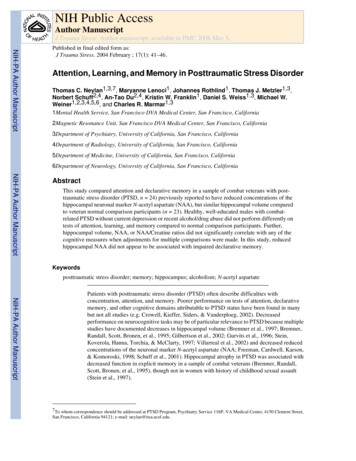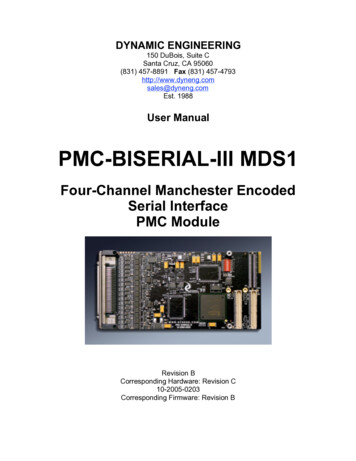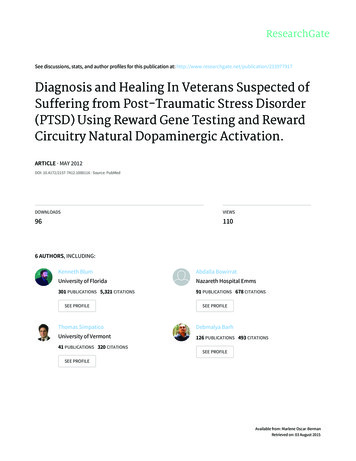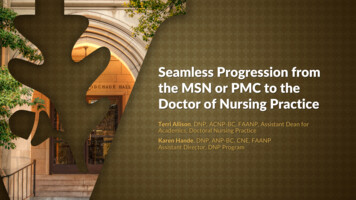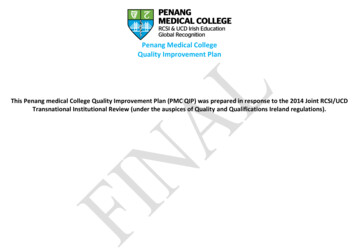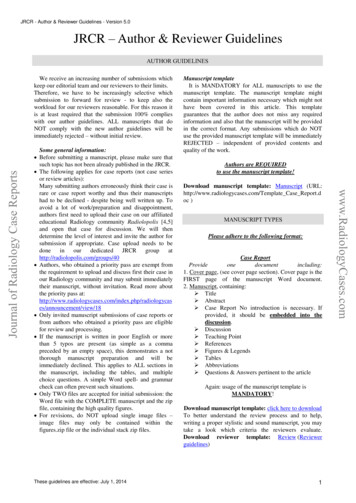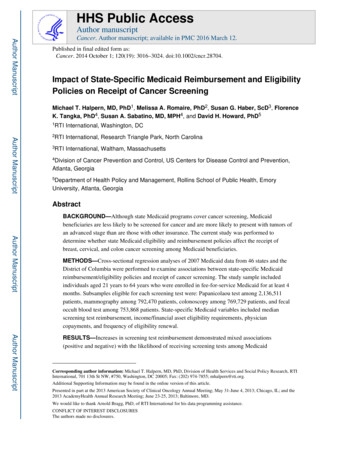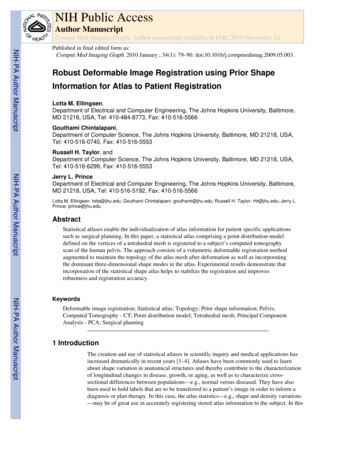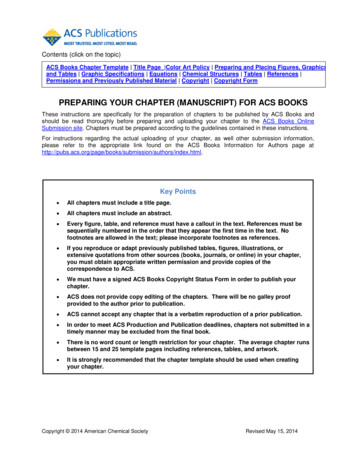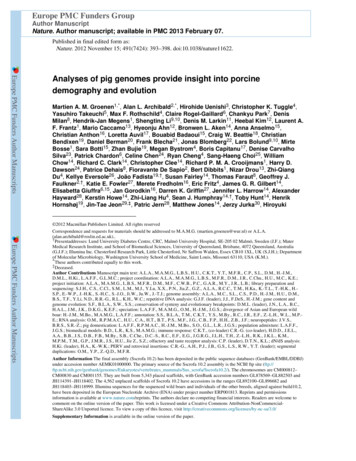
Transcription
Europe PMC Funders GroupAuthor ManuscriptNature. Author manuscript; available in PMC 2013 February 07.Published in final edited form as:Nature. 2012 November 15; 491(7424): 393–398. doi:10.1038/nature11622.Europe PMC Funders Author ManuscriptsAnalyses of pig genomes provide insight into porcinedemography and evolutionMartien A. M. Groenen1,*, Alan L. Archibald2,*, Hirohide Uenishi3, Christopher K. Tuggle4,Yasuhiro Takeuchi5, Max F. Rothschild4, Claire Rogel-Gaillard6, Chankyu Park7, DenisMilan8, Hendrik-Jan Megens1, Shengting Li9,10, Denis M. Larkin11, Heebal Kim12, Laurent A.F. Frantz1, Mario Caccamo13, Hyeonju Ahn12, Bronwen L. Aken14, Anna Anselmo15,Christian Anthon16, Loretta Auvil17, Bouabid Badaoui15, Craig W. Beattie18, ChristianBendixen19, Daniel Berman20, Frank Blecha21, Jonas Blomberg22, Lars Bolund9,10, MirteBosse1, Sara Botti15, Zhan Bujie19, Megan Bystrom4, Boris Capitanu17, Denise CarvalhoSilva23, Patrick Chardon6, Celine Chen24, Ryan Cheng4, Sang-Haeng Choi25, WilliamChow14, Richard C. Clark14, Christopher Clee14, Richard P. M. A. Crooijmans1, Harry D.Dawson24, Patrice Dehais8, Fioravante De Sapio2, Bert Dibbits1, Nizar Drou13, Zhi-QiangDu4, Kellye Eversole26, João Fadista19,†, Susan Fairley14, Thomas Faraut8, Geoffrey J.Faulkner2,†, Katie E. Fowler27, Merete Fredholm16, Eric Fritz4, James G. R. Gilbert14,Elisabetta Giuffra6,15, Jan Gorodkin16, Darren K. Griffin27, Jennifer L. Harrow14, AlexanderHayward28, Kerstin Howe14, Zhi-Liang Hu4, Sean J. Humphray14,†, Toby Hunt14, HenrikHornshøj19, Jin-Tae Jeon29,‡, Patric Jern28, Matthew Jones14, Jerzy Jurka30, Hiroyuki 2012 Macmillan Publishers Limited. All rights reservedEurope PMC Funders Author ManuscriptsCorrespondence and requests for materials should be addressed to M.A.M.G. (martien.groenen@wur.nl) or ddresses: Lund University Diabetes Centre, CRC, Malmö University Hospital, SE-205 02 Malmö, Sweden (J.F.); MaterMedical Research Institute, and School of Biomedical Sciences, University of Queensland, Brisbane, 4072 Queensland, Australia(G.J.F.); Illumina Inc. Chesterford Research Park, Little Chesterford, Nr Saffron Walden, Essex CB10 1XL, UK (S.J.H.); Departmentof Molecular Microbiology, Washington University School of Medicine, Saint Louis, Missouri 63110, USA (K.M.).*These authors contributed equally to this work.‡Deceased.Author Contributions Manuscript main text: A.L.A., M.A.M.G., L.B.S., H.U., C.K.T., Y.T., M.F.R., C.P., S.L., D.M., H.-J.M.,D.M.L., H.Ki., L.A.F.F., G.L.M.C.; project coordination: A.L.A., M.A.M.G., L.B.S., M.F.R., D.M., J.R., C.Chu., H.U., M.C., K.E.;project initiation: A.L.A., M.A.M.G., L.B.S., M.F.R., D.M., M.F., C.W.B., P.C., G.A.R., M.Y., J.R., L.B.; library preparation andsequencing: S.J.H., C.S., C.Cl., S.M., L.M., M.J., Y.Lu, X.X., P.N., Jia.Z., G.Z., A.L.A., R.C.C., T.M., H.Ka., K.-T.L., T.-H.K., H.S.P., E.-W.P., J.-H.K., S.-H.C., S.-J.O., Ji.W., Ju.W., J.-T.J.; genome assembly: A.L.A., M.C., S.L., C.S., P.D., H.-J.M., H.U., D.M.,B.S., T.F., Y.Li, N.D., R.R.-G., R.L., K.H., W.C.; repetitive DNA analysis: G.J.F. (leader), J.J., F.DeS., H.-J.M.; gene content andgenome evolution: S.F., B.L.A., S.W., S.S.; conservation of synteny and evolutionary breakpoints: D.M.L. (leader), J.N., L.A., B.C.,H.A.L., J.M., J.K., D.K.G., K.E.F.; speciation: L.A.F.F., M.A.M.G., O.M., H.-J.M., J.G.S.; divergence of Asian and European wildboar: H.-J.M., M.Bo., M.A.M.G., L.A.F.F.; annotation: S.S., B.L.A., T.M., C.K.T., Y.S., M.By., R.C., J.R., E.F., Z.-L.H., W.L., M.P.E.; RNA analysis: O.M., R.P.M.A.C., H.U., C.A., H.T., B.T., P.S., M.F., J.G., C.B., F.P., H.H., Z.B., J.F.; neuropeptides: J.V.S.,B.R.S., S.R.-Z.; pig domestication: L.A.F.F., R.P.M.A.C., H.-J.M., M.Bo., S.O., G.L., L.R., J.G.S.; population admixture: L.A.F.F.,J.G.S.; biomedical models: B.D., L.R., K.S., M.A.M.G.; immune response: C.K.T., (co-leader) C.R.-G. (co-leader), H.D.D., J.E.L.,A.A., B.B., J.S., D.B., F.B., M.By., S.B., C.Che., D.C.-S., R.C., E.F., E.G., J.G.R.G., J.L.H., T.H., Z.-L.H., R.K., J.K.L., K.M.,M.P.M., T.M., G.P., J.M.R., J.S., H.U., Jie Z., S.Z.; olfactory and taste receptor analysis: C.P. (leader), D.T.N., K.L.; dN/dS analysis:H.Ki. (leader), H.A., K.-W.K.; PERV and retroviral insertions: C.R.-G., A.H., P.J., J.B., G.S., L.S., R.W., Y.T. (leader); segmentalduplications: O.M., Y.P., Z.-Q.D., M.F.R.Author Information The final assembly (Sscrofa 10.2) has been deposited in the public sequence databases (GenBank/EMBL/DDBJ)under accession number AEMK01000000. The primary source of the Sscrofa 10.2 assembly is the NCBI ftp site /vertebrates mammals/Sus scrofa/Sscrofa10.2/). The chromosomes are CM000812–CM00830 and CM001155. They are built from 5,343 placed scaffolds, with GenBank accession numbers GL878569–GL882503 andJH114391–JH118402. The 4,562 unplaced scaffolds of Sscrofa 10.2 have accessions in the ranges GL892100–GL896682 andJH118403–JH118999. Illumina sequences for the sequenced wild boars and individuals of the other breeds, aligned against build10.2,have been deposited in the European Nucleotide Archive (ENA) under project number ERP001813. Reprints and permissionsinformation is available at www.nature.com/reprints. The authors declare no competing financial interests. Readers are welcome tocomment on the online version of the paper. This work is licensed under a Creative Commons Attribution-NonCommercialShareAlike 3.0 Unported licence. To view a copy of this licence, visit upplementary Information is available in the online version of the paper.
Groenen et al.Page 2Europe PMC Funders Author ManuscriptsKanamori3,31, Ronan Kapetanovic2, Jaebum Kim7,32, Jae-Hwan Kim33, Kyu-Won Kim34,Tae-Hun Kim35, Greger Larson36, Kyooyeol Lee7, Kyung-Tai Lee35, Richard Leggett13,Harris A. Lewin37, Yingrui Li9, Wansheng Liu38, Jane E. Loveland14, Yao Lu9, Joan K.Lunney20, Jian Ma39, Ole Madsen1, Katherine Mann20,†, Lucy Matthews14, StuartMcLaren14, Takeya Morozumi31, Michael P. Murtaugh40, Jitendra Narayan11, Dinh TruongNguyen7, Peixiang Ni9, Song-Jung Oh41, Suneel Onteru4, Frank Panitz19, Eung-WooPark35, Hong-Seog Park25, Geraldine Pascal42, Yogesh Paudel1, Miguel Perez-Enciso43,Ricardo Ramirez-Gonzalez13, James M. Reecy4, Sandra Rodriguez Zas44, Gary A. Rohrer45,Lauretta Rund44, Yongming Sang21, Kyle Schachtschneider44, Joshua G. Schraiber46,John Schwartz40, Linda Scobie47, Carol Scott14, Stephen Searle14, Bertrand Servin8, BruceR. Southey44, Goran Sperber48, Peter Stadler49, Jonathan V. Sweedler50, Hakim Tafer49, BoThomsen19, Rashmi Wali47, Jian Wang9, Jun Wang9,51, Simon White14, Xun Xu9, MartineYerle8, Guojie Zhang9,52, Jianguo Zhang9, Jie Zhang53, Shuhong Zhao53, Jane Rogers13,Carol Churcher14, and Lawrence B. Schook541AnimalEurope PMC Funders Author ManuscriptsBreeding and Genomics Centre, Wageningen University, De Elst 1, 6708 WD,Wageningen, The Netherlands. 2The Roslin Institute and R(D)SVS, University of Edinburgh,Easter Bush, Midlothian EH25 9RG, UK. 3National Institute of Agrobiological Sciences, 2-1-2Kannondai, Tsukuba, Ibaraki 305-8602, Japan. 4Department of Animal Science and Center forIntegrated Animal Genomics, Iowa State University, 2255 Kildee Hall, Ames 50011, USA. 5MRC/UCL Centre for Medical Molecular Virology and Wohl Virion Centre, Division of Infection &Immunity, University College London, Cruciform Building, Gower Street, London WC1E 6BT, UK.6INRA, Laboratory of Animal Genetics and Integrative Biology/AgroParisTech, Laboratory ofAnimal Genetics and Integrative Biology/CEA, DSV, IRCM, Laboratoire de Radiobiologie et Etudedu Génome, Domaine de Vilvert, F-78350 Jouy-en-Josas, France. 7Department of AnimalBiotechnology, Konkuk University, 1 Hwayang-dong, Kwangjin-gu, Seoul 143-701, South Korea.8INRA, Laboratoire de Génétique Cellulaire, Chemin de Borde-Rouge, Auzeville, 31320 CastanetTolosan, France. 9BGI-Shenzhen, Shenzhen 518083, China. 10Department of Biomedicine,Aarhus University, DK-8000 Aarhus C, Denmark. 11Institute of Biological, Environmental andRural Sciences, Aberystwyth University, Penglais Campus, Aberystwyth, Ceredigion SY23 3DA,UK. 12Department of Agricultural Biotechnology and C&K Genomics, Seoul National University,Gwanakgu, Seoul 151-742, South Korea. 13The Genome Analysis Centre, Norwich ResearchPark, Norwich NR4 7UH, UK. 14Wellcome Trust Sanger Institute, Wellcome Trust GenomeCampus, Hinxton, Cambridgeshire CB10 1SA, UK. 15Parco Tecnologico Padano, Via Einstein,Loc. C. Codazza, 26900 Lodi, Italy. 16Center for non-coding RNA in Technology and Health, IBHVUniversity of Copenhagen, Frederiksberg, Denmark. 17Illinois Informatics Institute, University ofIllinois, Urbana, Illinois 61801, USA. 18Department of Surgery, University of Illinois, Chicago,Illinois 60612, USA. 19Department of Molecular Biology and Genetics, Aarhus University,DK-8830 Tjele, Denmark. 20USDA ARS BARC Animal Parasitic Diseases Laboratory, Beltsville,Maryland 20705, USA. 21Department of Anatomy and Physiology, College of Veterinary Medicine,Kansas State University, Manhattan, Kansas 66506, USA. 22Clinical Virology, Department ofMedical Sciences, Uppsala University, Building D1, Academic Hospital, 751 85 Uppsala, Sweden.23European Bioinformatics Institute, Wellcome Trust Genome Campus, Hinxton, CambridgeshireCB10 1SD, UK. 24Diet, Genomics, Immunology Laboratory, Beltsville Human Nutrition ResearchCenter, United States Department of Agriculture, BARC-East 10300 Baltimore Ave Beltsville,Maryland 20705, USA. 25Korean Research Institute of Bioscience and Biotechnology, 125Gwahak ro, Yuseong gu, Daejeon 305-806, South Korea. 26Eversole Associates and the Alliancefor Animal Genome Research, 5207 Wyoming Road, Bethesda, Maryland 20816, USA. 27Schoolof Biosciences, The University of Kent, Giles Lane, Canterbury, Kent CT2 7NJ, UK. 28Science forLife Laboratory, Department of Medical Biochemistry and Microbiology, Uppsala University, BMC,Box 582, SE75123 Uppsala, Sweden. 29Department of Animal Sciences, College of Agricultureand Life Sciences, Gyeongsang National University, Jinju 660-701, South Korea. 30GeneticNature. Author manuscript; available in PMC 2013 February 07.
Groenen et al.Page 3Europe PMC Funders Author ManuscriptsEurope PMC Funders Author ManuscriptsInformation Research Institute, 1925 Landings Drive, Mountain View, California 94043, USA.31Institute of Japan Association for Techno-innovation in Agriculture, Forestry and Fisheries,446-1 Ippaizuka, Kamiyokoba, Tsukuba, Ibaraki 305-0854, Japan. 32Institute for GenomicBiology, University of Illinois, Urbana, Illinois 61801, USA. 33Animal Genetic Resources Station,National Institute of Animal Science, RDA, San 4, Yongsanri, Unbong eup, Namwon 590-832,South Korea. 34C&K Genomics, Gwanakgu, Seoul 151-742, South Korea. 35Animal Genomicsand Bioinformatics Division, National Institute of Animal Science, RDA, 77 Chuksan gil, Kwonsungu, Suwon 441-706, South Korea. 36Durham Evolution and Ancient DNA, Department ofArchaeology, Durham University, Durham DH1 3LE, UK. 37Department of Evolution and Ecology,The UC Davis Genome Center, University of California, Davis, California 95618, USA.38Department of Dairy and Animal Sciences, Center for Reproductive Biology and Health(CRBH), College of Agricultural Sciences, The Pennsylvania State University, 305 HenningBuilding, University Park, Pennsylvania 16802, USA. 39Department of Bioengineering andInstitute for Genomic Biology, University of Illinois, Urbana, Illinois 61801, USA. 40Department ofVeterinary and Biomedical Sciences, University of Minnesota, 1971 Commonwealth Avenue, StPaul, Minnesota 55108, USA. 41Jeju National University, 102 Jejudaehakno, Jeju 690-756, SouthKorea. 42INRA UMR85/CNRS UMR7247 Physiologie de la Reproduction et des Comportements/IFCE, F-37380 Nouzilly, France and Université François Rabelais de Tours, F-37041 Tours,France. 43ICREA, Centre for Research in Agricultural Genomics (CRAG) and Facultat deVeterinaria UAB, Campus Universitat Autonoma Barcelona, Bellaterra E-08193, Spain.44Department of Animal Sciences, University of Illinois, Urbana, Illinois 61801, USA. 45USDA,ARS, US Meat Animal Research Center, Clay Center, Nebraska 68933, USA. 46Department ofIntegrative Biology, University of California, Berkeley, California 94720-3140, USA. 47Departmentof Life Sciences, Glasgow Caledonian University, Glasgow G4 0BA, UK. 48Department ofNeuroscience, Biomedical Centre, Uppsala University, PO Box 593, 751 24 Uppsala, Sweden.49Bioinformatics Group, Department of Computer Science, Interdisciplinary Center forBioinformatics, Universität Leipzig, Leipzig, Germany. 50Department of Chemistry, University ofIllinois, Urbana, Illinois 61801, USA. 51Novo Nordisk Foundation Center for Basic MetabolicResearch and Department of Biology, University of Copenhagen, DK-2200 Copenhagen,Denmark. 52BGI-Europe, DK-2200 Copenhagen N, Denmark. 53Key Lab of Animal Genetics,Breeding, and Reproduction of Ministry Education, Huazhong Agricultural University, Wuhan430070 PR China, Huazhong Agricultural University, Wuhan 430070, China. 54Department ofAnimal Sciences and Institute for Genomic Biology, University of Illinois, Urbana, Illinois 61801,USA.AbstractFor 10,000 years pigs and humans have shared a close and complex relationship. Fromdomestication to modern breeding practices, humans have shaped the genomes of domestic pigs.Here we present the assembly and analysis of the genome sequence of a female domestic Durocpig (Sus scrofa) and a comparison with the genomes of wild and domestic pigs from Europe andAsia. Wild pigs emerged in South East Asia and subsequently spread across Eurasia. Our resultsreveal a deep phylogenetic split between European and Asian wild boars 1 million years ago, anda selective sweep analysis indicates selection on genes involved in RNA processing andregulation. Genes associated with immune response and olfaction exhibit fast evolution. Pigs havethe largest repertoire of functional olfactory receptor genes, reflecting the importance of smell inthis scavenging animal. The pig genome sequence provides an important resource for furtherimprovements of this important livestock species, and our identification of many putative diseasecausing variants extends the potential of the pig as a biomedical model.Nature. Author manuscript; available in PMC 2013 February 07.
Groenen et al.Page 4Europe PMC Funders Author ManuscriptsThe domestic pig (Sus scrofa) is a eutherian mammal and a member of the Cetartiodactylaorder, a clade distinct from rodent and primates, that last shared a common ancestor withhumans between 79 and 97 million years (Myr) ago1,2 (http://www.timetree.net). Moleculargenetic evidence indicates that Sus scrofa emerged in South East Asia during the climaticfluctuations of the early Pliocene 5.3–3.5 Myr ago. Then, beginning 10,000 years ago, pigswere domesticated in multiple locations across Eurasia3 (Frantz, L. A. F. et al., manuscriptsubmitted).Here we provide a high-quality draft pig genome sequence developed under the auspices ofthe Swine Genome Sequencing Consortium4,5, established using bacterial artificialchromosome (BAC)6 and whole-genome shotgun (WGS) sequences (see Methods andSupplementary Information). The assembly (Sscrofa 10.2) comprises 2.60 gigabases (Gb)assigned to chromosomes with a further 212 megabases (Mb) in unplaced scaffolds (Table 1and Supplementary Tables 1–3).Genome annotationA de novo repeat discovery and annotation strategy (Supplementary Fig. 8) revealed a totalof 95 novel repeat families, including: 5 long interspersed elements (LINEs), 6 shortinterspersed elements (SINEs), 8 satellites and 76 long terminal repeats (LTRs). The relativecontent of repetitive elements ( 40%, Supplementary Figs 9 and 10) is lower than reportedfor other mammalian genomes. The main repetitive element groups are the LINE1 andglutamic acid transfer RNA (tRNAGlu)-derived SINEs or PRE (porcine repetitive element).The expansion of PRE is specific to the porcine lineage. Phylogenetic analysis of LINE1 andPRE (Supplementary Figs 13 and 14) indicates that only a single lineage of each is currentlyactive and that the main expansion of both LINE1 and PRE occurred in the first half of theTertiary period. Smaller expansions, particularly in LINE1, have occurred since, but recentactivity is very low (Supplementary Information).Europe PMC Funders Author ManuscriptsAnnotation of genes, transcripts and predictions of orthologues and paralogues wasperformed using the Ensembl analysis pipeline7 (Table 1 and Supplementary Figs 3–7).Further annotation for non-protein-coding RNAs (ncRNAs) was undertaken with anotheranalysis pipeline (Supplementary Information and Supplementary Table 4).Evolution of the porcine genomeEvolution of genes and gene familiesTo examine the mutation rate and type of protein-coding genes that show acceleratedevolution in pigs, we identified 9,000 as 1:1 orthologues within a group of six mammals(human, mouse, dog, horse, cow and pig). This orthologous gene set was used to identifyproteins that show accelerated evolution in each of these six mammalian lineages(Supplementary Information). The observed number of synonymous substitutions persynonymous site (dS) for the pig lineage (0.160) is similar to that of the other mammals(0.138–0.201) except for the mouse (0.458), indicating similar evolutionary rates in pigs andother mammals. The observed dN/dS ratio (ratio of the rate of non-synonymoussubstitutions to the rate of synonymous substitutions) of 0.144 is between those of humans(0.163) and mice (0.116), indicating an intermediate level of purifying selection pressure inthe pig. Genes showing increased dN/dS ratios in each lineage were analysed using DAVID8to examine whether these rapidly evolving genes were enriched for specific biologicalprocesses. Most lineages show different fast-evolving pathways, but some pathways areshared (Fig. 1).Nature. Author manuscript; available in PMC 2013 February 07.
Groenen et al.Page 5Europe PMC Funders Author ManuscriptsImmune genes are known to be actively evolving in mammals9,10. Because many immunegenes were not included in the analysis of 1:1 orthologues, we examined a randomlyselected subset of 158 immunity-related pig proteins for evidence of accelerated evolution(Supplementary information). Twenty-seven of these genes (17%) demonstrated acceleratedevolution (Supplementary Table 8). A parallel analysis of 143 human and 145 bovineorthologues revealed very similar rates of evolution (18% in human and 12% in cattle,respectively). Using a branch-site analysis, we detected accelerated evolution of amino acidsin PRSS12, CD1D and TRAF3 specific to pig (positive selection on pig branch), as well asamino acids in TREM1, IL1B and SCARA5 specific to pig and cow (positive selection onthe cetartiodactyl branch).Further analysis of porcine immune genes (Supplementary Table 5) revealed evidence forspecific gene duplications and gene-family expansions (Supplementary Tables 6 and 7). Theanalysis of this second cetartiodactylgenome indicates that someexpansions arecetartiodactyl-specific (cathelicidin) whereas others are ruminant/bovine-specific (βdefensins, C-type lyzozymes) or potentially porcine-specific (type I interferon, δ subfamily).Pigs have at least 39 type I interferon (IFN) genes, which is twice the number identified inhumans and significantly more than in mice. We also detected 16 pseudogenes in thisfamily. Cattle have 51 type I IFNs (13 pseudogenes), indicating that both bovine and porcinetype I IFN families have undergone expansion. This is particularly important for interferonsubtypes δ (IFND), ω (IFNW) and τ (IFNT); pigs and cattle are evolving species-specificsubtypes of IFND and IFNT, respectively. Both species are expanding the IFNW family andshare many more IFNW isoforms than other species. Thus, expansion of interferon genes isnot ruminant-specific as proposed earlier10, although duplication within some specific subfamilies seems to be either bovine-or porcine-specific.Europe PMC Funders Author ManuscriptsWithin the immunity-related genes annotated, we found evidence for duplication of siximmune-related genes: IL1B, CD36, CD68, CD163, CRP and IFIT1, and one non-immunegene, RDH16. The CD36 gene is also duplicated in the bovine genome, whereas the IL1Bgene duplication, where evidence for a partial duplication was reported previously11, isunique in mammals. Other key immune genes in the major histocompatibility complex,immunoglobulin, T-cell-receptor and natural killer cell receptor loci have been characterizedin detail12–19 (Supplementary Information).Another significant porcine genome expansion is the olfactory receptor gene family. Weidentified 1,301 porcine olfactory receptor genes and 343 partial olfactory receptor genes20.The fraction of pseudogenes within these olfactory receptor sequences (14%) is the lowestobserved in any species so far. This large number of functional olfactory receptor genesmost probably reflects the strong reliance of pigs on their sense of smell while scavengingfor food.Conservation of synteny and evolutionary breakpointsAlignment of the porcine genome against seven other mammalian genomes (SupplementaryInformation) identified homologous synteny blocks (HSBs). Using porcine HSBs andstringent filtering criteria, 192 pig-specific evolutionary breakpoint regions (EBRs) werelocated. The number of porcine EBRs (146, Supplementary Table 11 and SupplementaryFig. 16) is comparable to the number of bovine-lineage-specific EBRs (100) reported earlierusing a slightly lower resolution (500 kilobases (kb)), indicating that both lineages evolvedwith an average rate of 2.1 large-scale rearrangements per million years after thedivergence from a common cetartiodactyl ancestor 60 Myr ago2. This rate compares to 1.9 rearrangements per million years within the primate lineage (Supplementary Table 11).Nature. Author manuscript; available in PMC 2013 February 07.
Groenen et al.Page 6A total of 20 and 18 cetartiodactyl EBRs (shared by pigs and cattle) were detected using thepig and human genomes as a reference, respectively.Europe PMC Funders Author ManuscriptsPig-specific EBRs were enriched for LTR endogenous retrovirus 1 (LTR-ERV1)transposons and satellite repeats (Supplementary Table 12), indicating that these twofamilies of repetitive sequences have contributed to chromosomal evolution in the piglineage. Different families of transposable elements seem to have been active in thecetartiodactyl ancestor. The cetartiodactyl EBRs are enriched for LINE1 elements andtRNAGlu-derived SINEs. tRNAGlu-derived SINEs, previously found over-represented incetartiodactyl EBRs defined in the bovine genome10, originated in the common ancestor ofcetartiodactyls21. Our observation that these elements are also enriched in porcine EBRsstrongly supports the hypothesis that active transposable elements promote lineage-specificgenomic rearrangements.Europe PMC Funders Author ManuscriptsA stringent set of porcine to human one-to-one orthologues using the MetaCore databaserevealed that porcine EBRs and adjacent intervals are enriched for genes involved in sensoryperception of taste (P 8.9 10 6; FDR 0.05), indicating that taste phenotypes may havebeen affected by events associated with genomic rearrangements. Pigs have a limited abilityto taste NaCl22. SCNN1B, a gene encoding a sodium channel involved in the perception ofsalty tastes, is located in a porcine-specific EBR. Another gene, ITPR3, encoding a receptorfor inositol triphosphate and a calcium channel involved in the perception of umami andsweet tastes, has been affected by the insertion of several porcine-specific SINE mobileelements into its 3′ untranslated region (3′ UTR), consistent with our observation of ahigher density of transposable elements in EBRs. In addition to 8 bitter taste receptor genesannotated by Ensembl and which were used in the gene enrichment analysis, we identified 9intact genes, to give a total number of 17 TAS2R receptors in the pig (Supplementary Table13). This compares to 18 intact bitter taste receptors in cattle, 19 in horse, 15 in dog and 25in humans23,24. Of the 14 bitter taste receptor genes that were mapped to a specific pigchromosome (SSC), 10 were found near 2 EBRs on SSC5 and SSC18 (SupplementaryTables 13 and 15). We also found that at least four taste receptors (TAS1R2, TAS2R1,TAS2R40 and TAS2R39) have been under relaxed selection (Supplementary Information).Pigs are not sensitive to bitter tastes and tolerate higher concentrations of bitter compoundsthan humans22,25. Thus, pigs can eat food that is unpalatable to humans. A review of theporcine taste transduction network (Supplementary Fig. 17) revealed additional genesaffected by rearrangements that affect ‘apical and taste receptor cell’ processes. Togetherwith the observed over-representation of genes related to ‘adrenergic receptor activity’ and‘angiotensin and other binding’ categories in the pig EBRs (Supplementary Fig. 18), ourdata indicate that chromosomal rearrangements significantly contributed to adaptation in thesuid lineage.Population divergence and domesticationDivergence between Asian and European wild boarWe investigated the evolution within Sus scrofa in Eurasia by sequencing ten individualunrelated wild boars from different geographical areas. In total, 17,210,760 single nucleotidepolymorphisms (SNPs) were identified among these ten wild boars. The number of SNPssegregating in the four Asian wild boars (11,472,192) was much higher than that observed inthe six European wild boars (6,407,224) with only 2,212,288 shared SNPs. This highernucleotide diversity was visible in the distribution of heterozygous sites of the Asiancompared to the European wild boar genomes (Fig. 2). Phylogenomic analyses of completegenome sequences from these wild boars and six domestic pigs revealed distinct Asian andEuropean lineages (Supplementary Fig. 23) that split during the mid-Pleistocene 1.6–0.8Myr ago (Calabrian stage, Frantz, L. A. F. et al., manuscript submitted). Colder climatesNature. Author manuscript; available in PMC 2013 February 07.
Groenen et al.Page 7Europe PMC Funders Author Manuscriptsduring the Calabrian glacial intervals probably triggered isolation of populations acrossEurasia. Admixture analyses (Supplementary Information) within Eurasian Sus scrofadisclosed gene flow between the northern Chinese and European populations consistent withpig migration across Eurasia, between Europe and northern China, throughout thePleistocene. Our demographic analysis on the whole-genome sequences of European andAsian wild boars (Fig. 3) revealed an increase in the European population after pigs arrivedfrom China. During the Last Glacial Maximum (LGM; 20,000 years ago)26, however,Asian and European populations both suffered population bottlenecks. The drop inpopulation size was more pronounced in Europe than Asia (Fig. 3), suggesting a greaterimpact of the LGM in northern European regions and probably resulting in the observedlower genetic diversity in modern European wild boar.The deep phylogenetic split between European and Asian wild boars is further supported byour observation of 1,272,737 fixed differences between the six European and four Asianwild boars, 1,706 of which are non-synonymous mutations in 1,191 different genes. Genesinvolved in sensory perception, immunity and host defence were among the most rapidlyevolving genes (Supplementary Table 28), further strengthening the conclusions from ouranalysis of immunity-related pig proteins. This conclusion is further supported by ourobservation that these genes are also enriched in porcine segmental duplications(Supplementary Information).Europe PMC Funders Author ManuscriptsTo investigate further whether specific regions in the genome of European and Asian wildboar have been under positive selection, a selective sweep analysis was performed on the tenwild boar genome sequences using an approach similar to that recently described in thecomparison of Neanderthal and Homo sapiens genomes27. Regions in the genome understrong positive selection after the divergence of these two populations are expected to sharefewer derived alleles. Using stringent criteria (Supplementary Information), we identified atotal of 251 putative selective sweep regions, with an average size of 111,269 base pairs(bp), together comprising around 1% of the genome and harbouring 365 annotated proteincoding genes (Supplementary Table 26). Many of these regions (112) do not contain anycurrently annotated protein-coding exons. In contrast, the 10 putative selective sweepregions located between positions 39–43 Mb on SSC3 together harbour 93 genes. This SSC3region (Supplementary Fig. 25) is directly adjacent to the centromere and exhibits lowrecombination rates28. Low recombining regions have been shown to be more prone toselective sweeps and meiotic drive29,30. Although similar large putative selective sweepregions close to the centromere were only observed on SSC6 between positions 56.2–57.5Mb, on most chromosomes selective sweep regions tended to cluster in the central part ofchromosomes, thus exhibiting a clear correlation with regions of low recombination(Supplementary Fig. 27). As expected, regions with the highest nucleotide differentiationbetween European and Asian wild boars were observed in high recombination regionstowards the end of the chromosomes on both metacentric and acrocentric chromosomes28.The putative selective sweep regions displayed significant over-representation of genesinvolved in RNA splicing and RNA processing, indicating possible changes in the regulationof genes at the level of RNA processing (Supplementary Table 27). Several of these genes(CELF1, CELF6, WDR83, RBM39, RBM6, HNRNPA1, HNRNPM) are involved inalternative splicing, and, small differences in expression m
Life Laboratory, Department of Medical Biochemistry and Microbiology, Uppsala University, BMC, Box 582, SE75123 Uppsala, Sweden. 29Department of Animal Sciences, College of Agriculture and Life Sciences, Gyeongsang National University, Jinju 660-701, South Korea. 30Genetic Groenen et al. Page 2 Nature. Author manuscript; available in PMC 2013 .
